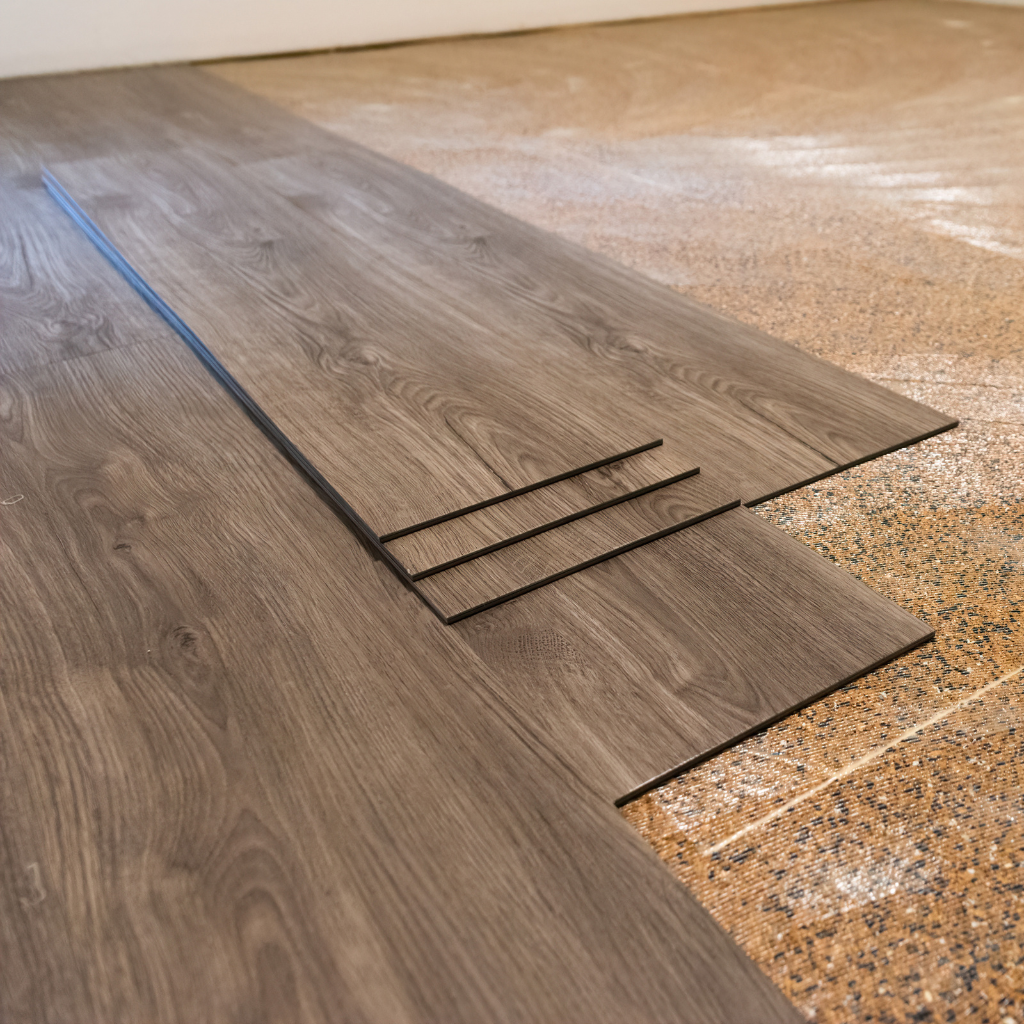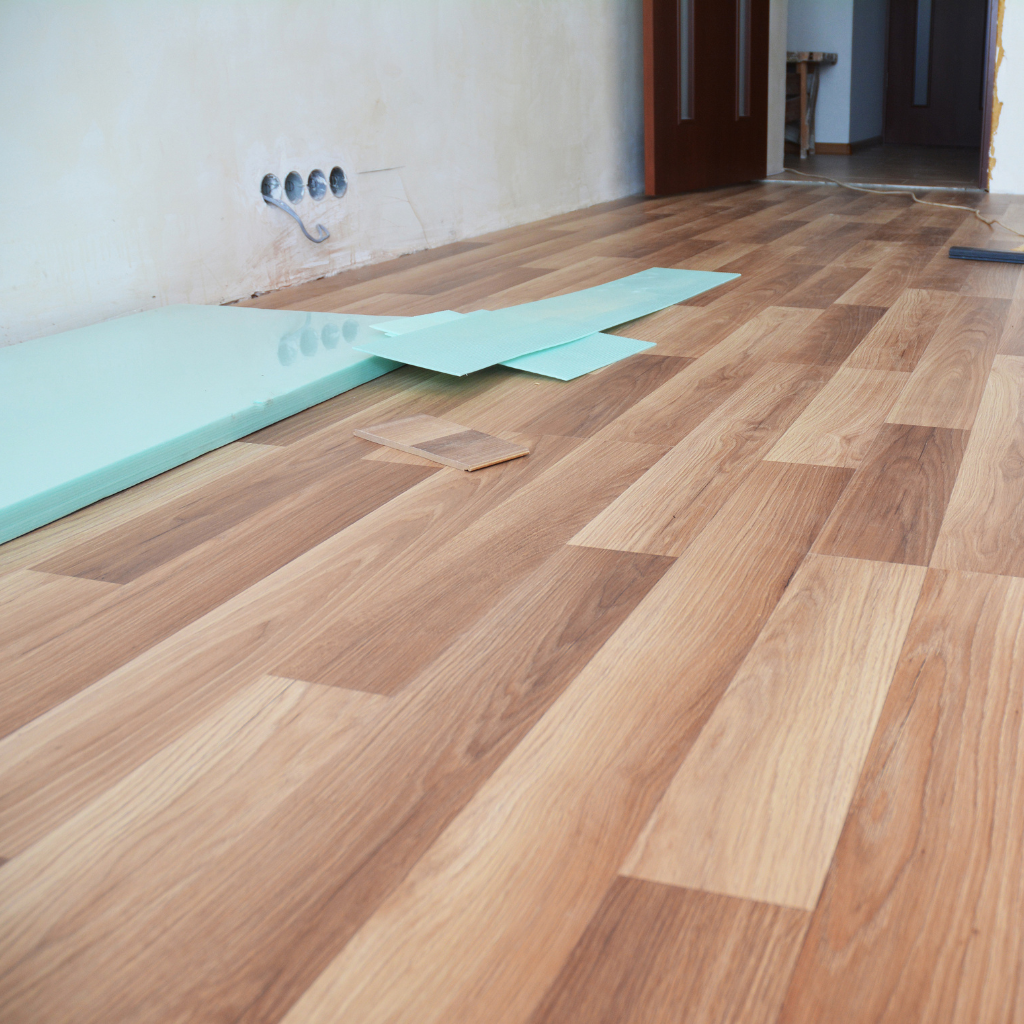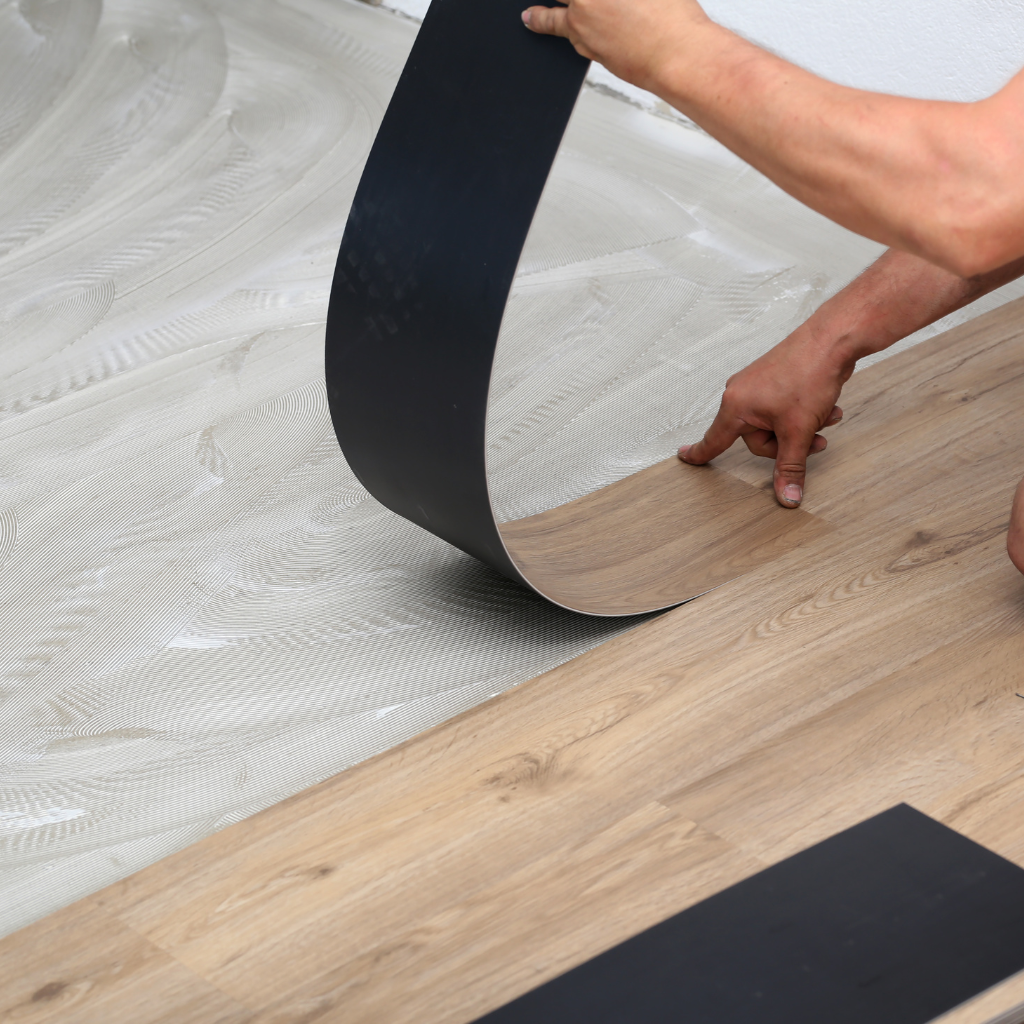
Blog test
What Is the Difference Between Laminate and Vinyl Flooring Options?
Laminate and vinyl flooring differ in composition, durability, and installation. Laminate consists of a fiberboard core, photographic layer, and protective wear layer, resembling wood or stone. Vinyl is primarily polyvinyl chloride, offering diverse designs, including luxury options. Vinyl outperforms laminate in moisture resistance and longevity, especially in high-traffic areas. Installation varies: laminate requires precise fitting, while vinyl offers easier methods. These characteristics inform their suitability for specific applications and environments, offering insights into ideal flooring choices.
Key Takeaways
- Vinyl flooring is more moisture-resistant than laminate, making it suitable for high-moisture areas like kitchens and bathrooms.
- Laminate mimics wood or stone finishes with textured high-resolution photographic layers, while vinyl offers a broader range of designs and patterns.
- Vinyl is more durable, resistant to scratches and stains, and requires less maintenance than laminate.
- Laminate generally has lower initial material costs, but vinyl’s long-term savings may be higher due to its durability and maintenance ease.
- Installation of vinyl is typically easier and less costly compared to laminate, which requires precise fitting and often additional underlayment.
What’s the difference between vinyl and laminate flooring?
Laminate and vinyl flooring differ fundamentally in their composition and structural elements. Laminate typically consists of a fiberboard core layered with a photographic applique and protective overlay, whereas vinyl is composed of synthetic materials such as polyvinyl chloride (PVC).
From an aesthetic perspective, laminate often mimics the appearance of wood and stone with high-resolution imaging. At the same time, vinyl offers a broader range of design options, including intricate patterns and textures.
Experts recommend considering the specific installation environment and desired durability, as these factors can considerably influence the ideal choice between the two materials.

Understanding the difference between laminate and vinyl
How do laminate and vinyl flooring differ regarding composition, durability, and application? Vinyl flooring, particularly in its luxury vinyl plank form, is inherently waterproof, making it suitable for moisture-prone areas. Laminate flooring, while mimicking natural wood aesthetics, lacks this waterproof capability, thereby limiting its application in wet spaces. The selection of these flooring materials depends on their pros and cons, including installation ease, cost-effectiveness, and visual appeal. The following table provides a snapshot of key differences:
| Feature | Vinyl Flooring | Laminate Flooring |
|---|---|---|
| Waterproof | Yes | No |
| Appearance | Versatile | Natural Wood Look |
| Durability | High in wet areas | Better in dry areas |
Choosing the right flooring involves understanding these nuances to achieve the desired practicality and aesthetics.
Key differences in composition and structure
While understanding the practical differences between laminate and vinyl flooring is important, examining their composition and structure provides deeper insights into their performance characteristics.
Laminate flooring consists of multiple layers, including a high-density fiberboard core, a photographic layer that mimics wood or stone, and a protective wear layer. This flooring type is typically installed in laminate planks.
In contrast, vinyl flooring, including luxury vinyl planks, vinyl plank flooring, and sheet vinyl, is composed primarily of polyvinyl chloride (PVC), which grants superior water resistance. The structure of vinyl options often includes a wear layer, a printed design layer, and a backing layer.
Experts recommend considering the environment, as laminate flooring may be more suitable for dry areas, whereas vinyl flooring excels in moisture-prone spaces.
Visual and aesthetic differences
A significant distinction in the visual and aesthetic attributes of laminate and vinyl flooring lies in their surface textures and design capabilities.
Laminate flooring is renowned for its realistic wood or stone finishes due to high-resolution photographic layers and embossed textures. In contrast, vinyl flooring, particularly luxury vinyl plank flooring, provides diverse aesthetic differences through its ability to mimic a variety of materials with water-resistant properties.
- Laminate Floor: Offers a wide array of wood flooring or stone-like appearances with textured finishes.
- Vinyl Floor: Available in multiple types of vinyl flooring, known for its versatility and moisture resistance.
- Luxury Vinyl Plank Flooring: Provides a high-end aesthetic with durability and realistic visuals.
- Flooring Option: Selection depends on desired aesthetic, environmental conditions, and budget considerations.
Both flooring options offer unique visual differences tailored to consumer preferences.
Is vinyl or laminate flooring more durable?
When analyzing durability, vinyl flooring demonstrates superior resistance to moisture, scratches, and stains due to its multi-layered construction and protective wear layer, making it ideal for high-traffic and wet areas.
In contrast, laminate flooring, while robust due to its dense fiberboard core and resin coating, is more susceptible to water damage and requires careful installation to maintain its longevity in everyday use. Typically, laminate flooring is made from high-density fiberboard with a photographic layer that mimics natural materials.
Experts recommend vinyl for environments prone to moisture exposure, while laminate may suffice for areas with lower moisture levels and fewer wear concerns.
Durability of vinyl flooring
Vinyl flooring, known for its resilience and adaptability, often surpasses laminate in terms of durability, especially in high-moisture environments.
This durability is attributed to how vinyl flooring is made, using multiple layers that enhance its water resistance and wear resilience.
Luxury vinyl flooring, including vinyl plank and vinyl tile variations, exemplifies advancements in quality vinyl flooring.
The benefits of vinyl flooring include its suitability for areas prone to moisture and heavy foot traffic.
- Water Resistance: Ideal for kitchens, bathrooms, and basements.
- Scratch and Dent Resistance: Quality vinyl flooring resists everyday wear and tear.
- Durability Versus Thickness: Thin vinyl flooring can be as durable as thicker options when using high-quality materials.
- Easy Maintenance: Vinyl flooring products require minimal upkeep, enhancing longevity.
Such attributes make vinyl flooring planks a preferred choice for durability.
Is Laminate Flooring Durable for Everyday Use?
How does laminate flooring hold up under the rigors of daily use?
Laminate flooring is renowned for its durability, engineered with a high-density fiberboard core topped by a photographic applique layer and a protective clear coat. This construction allows it to resist scratches and dents, making it a robust choice for high-traffic areas.
However, when comparing laminate vs vinyl flooring, laminate’s water resistance is inferior; it can swell with prolonged moisture exposure. The difference between laminate vs vinyl highlights vinyl’s superior water resistance, an essential factor in flooring for your home.
When choosing between laminate and vinyl, consider the pros and cons of laminate: it offers aesthetic versatility and ease of installation.
Expert recommendations suggest installing laminate in dry areas to optimize longevity.

What are the pros and cons of each flooring type?
When comparing laminate and vinyl flooring, each presents distinct advantages and limitations that influence their suitability for specific applications.
Vinyl flooring is renowned for its water resistance and ease of maintenance, making it an ideal choice for moisture-prone areas. In contrast, laminate flooring offers superior aesthetic versatility with its realistic wood appearance.
Cost analysis reveals that while both options are generally affordable, laminate may present a more budget-friendly solution, though it may require more careful installation to avoid damage.
Vinyl flooring pros and cons
While evaluating flooring options, learn the pros and cons of vinyl flooring is essential for making an informed decision.
Vinyl flooring offers versatility and ease of installation, especially when compared to laminate flooring. The material’s durability and the variety of forms of vinyl flooring, such as luxury vinyl options and sheet vinyl flooring, make it a popular choice.
However, determining the right flooring involves analyzing potential drawbacks.
Pros:
- Water-resistant and suitable for damp areas.
- Cost-effective compared to luxury alternatives.
- Available in numerous designs and finishes.
- Simple to install vinyl with minimal tools required.
Cons:
- Susceptible to scratches and dents.
- Can fade under prolonged exposure to sunlight.
- Difficult to repair without replacing entire sections.
- Limited resale value compared to other materials.
Pros and cons of Laminate Flooring
Following the examination of vinyl flooring, laminate flooring emerges as another viable option with distinct advantages and disadvantages.
Among the benefits, laminate flooring is renowned for its aesthetic appeal, closely resembling natural wood or stone at a fraction of the cost. Its installation process is straightforward, often featuring a click-lock mechanism that simplifies fitting. Laminate durability is notable, resisting scratches and wear in high-traffic areas.
However, a key drawback is its limited moisture resistance, making it less suitable for damp environments compared to vinyl.
In the laminate vs vinyl debate, laminate flooring offers a robust appearance and is a cost-effective choice but demands careful consideration of its environmental exposure. Experts recommend laminate flooring for areas where moisture exposure is minimal.
Cost comparing laminate and vinyl
In comparing the costs of laminate and vinyl flooring, several factors must be considered to determine the most economical choice for specific requirements.
When conducting a cost comparison, attention must be paid to both material and installation costs. The affordability of flooring options can vary greatly based on these elements.
- Material costs: Vinyl flooring typically incurs higher material expenses due to its durability and water resistance.
- Installation costs: Laminate flooring often presents a more budget-friendly option, as it is generally easier and quicker to install.
- Price difference: The price gap can fluctuate based on design complexity and quality grade of each flooring type.
- Cost-effective solution: Vinyl may offer long-term savings in high-moisture areas, while laminate suits dry environments.
This analysis emphasizes strategic selection based on usage needs.
How easy is it to install laminate or vinyl flooring?
The installation process for vinyl vs laminate flooring varies in complexity and technique, with each requiring specific steps and tools to guarantee optimal results.
Laminate flooring typically involves a click-lock mechanism, necessitating precise alignment and acclimatization. In contrast, vinyl flooring can be installed through peel-and-stick, glue-down, or interlocking methods, each with distinct substrate preparation requirements.
Experts recommend avoiding common pitfalls such as inadequate subfloor preparation and improper seam alignment to enhance the durability and aesthetic appeal of both flooring types.
Steps to install laminate flooring
Key installation steps include:
- Utilize the locking system for secure plank connections.
- Employ a tapping block to guarantee tight seams without damaging edges.
- Install trim pieces for a professional finish.
- Maintain expansion gaps around room perimeters to allow for natural plank movement.
How to Install Vinyl Flooring
Installing vinyl flooring requires a methodical approach to confirm durability and aesthetic appeal. The installation process begins with meticulous subfloor preparation to guarantee a smooth, level surface, which is vital for preventing future damage.
For areas prone to moisture, applying a moisture barrier is recommended. Vinyl flooring offers two primary installation methods: adhesive application and floating floor systems. The adhesive method involves securing vinyl tiles or planks directly to the subfloor.
Alternatively, the click-lock system offers a floating floor, where planks interlock without glue. This system requires precise cutting of vinyl planks to fit the space accurately. An underlayment may be used for added comfort and sound reduction.
Expert recommendations emphasize careful planning and execution for a successful installation.
Common installation mistakes to avoid
Meticulous preparation and execution are paramount in vinyl flooring installation, yet common mistakes can undermine efforts. Proper subfloor preparation is vital; uneven surfaces lead to premature wear.
Neglecting acclimation of laminate flooring can result in warping due to environmental changes. A moisture barrier is key for preventing subfloor moisture from damaging vinyl flooring. Errors in underlayment selection can affect insulation and soundproofing.
Avoid these typical installation mistakes:
- Adhesive application: Inconsistent application results in weak bonding or bubbling.
- Cutting techniques: Inaccurate cuts compromise fit, leading to visible gaps.
- Expansion gaps: Failure to leave adequate spaces causes buckling as materials expand.
- Moisture barrier omission: Skipping this protective layer of laminate flooring risks moisture damage.
Correcting these errors guarantees durability and aesthetic appeal in laminate and vinyl flooring.
How do I choose the right flooring for my home?
Selecting the appropriate flooring for a home requires an evaluation of multiple factors, such as the durability and water resistance of laminate versus vinyl, which directly impacts their suitability for different room types.
Experts recommend evaluating high-moisture areas like bathrooms and kitchens for vinyl flooring due to its superior water resistance, whereas laminate is advisable in low-moisture spaces.
Budgetary constraints also play an essential role, necessitating a cost-benefit analysis to determine the most economically feasible option without compromising on quality and performance.
Factors to consider when choosing between laminate and vinyl
When evaluating flooring options, understanding the distinct properties of laminate and vinyl is essential for making an informed decision.
The difference between laminate and vinyl flooring can greatly impact the choice of the perfect flooring for a home. A detailed comparison of laminate vs vinyl reveals several factors to take into account:
- Durability: Vinyl generally offers superior resistance to moisture, making it suitable for areas prone to spills, while laminate may be more susceptible to water damage.
- Installation: Both types of flooring feature straightforward installation processes, but vinyl often requires less preparation and can be installed over existing floors.
- Aesthetics: Laminate typically provides a more authentic wood-like appearance, while vinyl offers a wider range of styles.
- Cost: Comparing laminate and vinyl, vinyl can be more cost-effective, but both have affordable options.
Impact of room type on flooring choice
Although personal preference plays a significant role, the functionality of a room should be a primary consideration when determining the ideal flooring type.
Bathrooms and kitchens, with high moisture levels, benefit from vinyl flooring due to its superior water resistance and moisture resistance. In contrast, living rooms and bedrooms prioritize comfort and appearance, making laminate flooring an appealing choice due to its realistic hardwood flooring aesthetics and softer underfoot feel.
Durability is essential in high-traffic areas, and both vinyl and laminate flooring perform well in this regard. Installation ease varies, with vinyl often being more straightforward.
Maintenance demands differ, with vinyl typically requiring less upkeep. Ultimately, selecting the appropriate flooring hinges on evaluating room type, durability, installation, appearance, comfort, and maintenance requirements.

Budget considerations for laminate flooring and vinyl flooring
In evaluating budget considerations for vinyl flooring and laminate flooring, it is essential to analyze the cost-effectiveness relative to the flooring’s longevity, installation expenses, and maintenance costs.
Both laminate and vinyl flooring present distinct pricing structures and affordability. Experts recommend a thorough cost comparison to determine the most suitable option for specific needs.
Key factors include:
- Installation Costs: Vinyl flooring typically offers lower installation costs due to its flexibility and ease of handling, while laminate may require more precise fitting and underlayment.
- Maintenance Costs: Vinyl flooring is generally more durable and water-resistant, reducing long-term maintenance expenses.
- Longevity: Vinyl’s resilience often surpasses laminate, providing better longevity.
- Pricing and Affordability: Laminate flooring usually has a lower initial cost but may incur higher maintenance or replacement expenses over time.
This analysis aids in selecting the best flooring option.
Conclusion
To sum up, selecting between laminate and vinyl flooring requires careful consideration of specific needs and conditions. Vinyl flooring, with its superior water resistance and durability, is ideal for moisture-prone areas. Laminate, known for its realistic wood appearance, appeals to those prioritizing aesthetics. Both options are relatively easy to install, though vinyl offers greater flexibility. Ultimately, the choice hinges on balancing factors such as environmental conditions, budget, and desired aesthetic outcome, guided by expert recommendations.
-
What Is the Difference Between Laminate and Vinyl Flooring Options?24 Jun 2025
-
How to Repair Scratched Laminate Flooring: Fix Scratches and Repair Tips21 Jun 2025
-
How to Install Laminate Flooring: Steps to Achieve a Perfect Floor Finish18 Jun 2025
-
How to Polish Natural Stone Floor Tiles for a Shiny Finish15 Jun 2025
-
Key Difference Between Ceramic and Porcelain Tile for Home Interiors12 Jun 2025
-
Different Types of Tile: What Type is Right for Each Room?09 Jun 2025